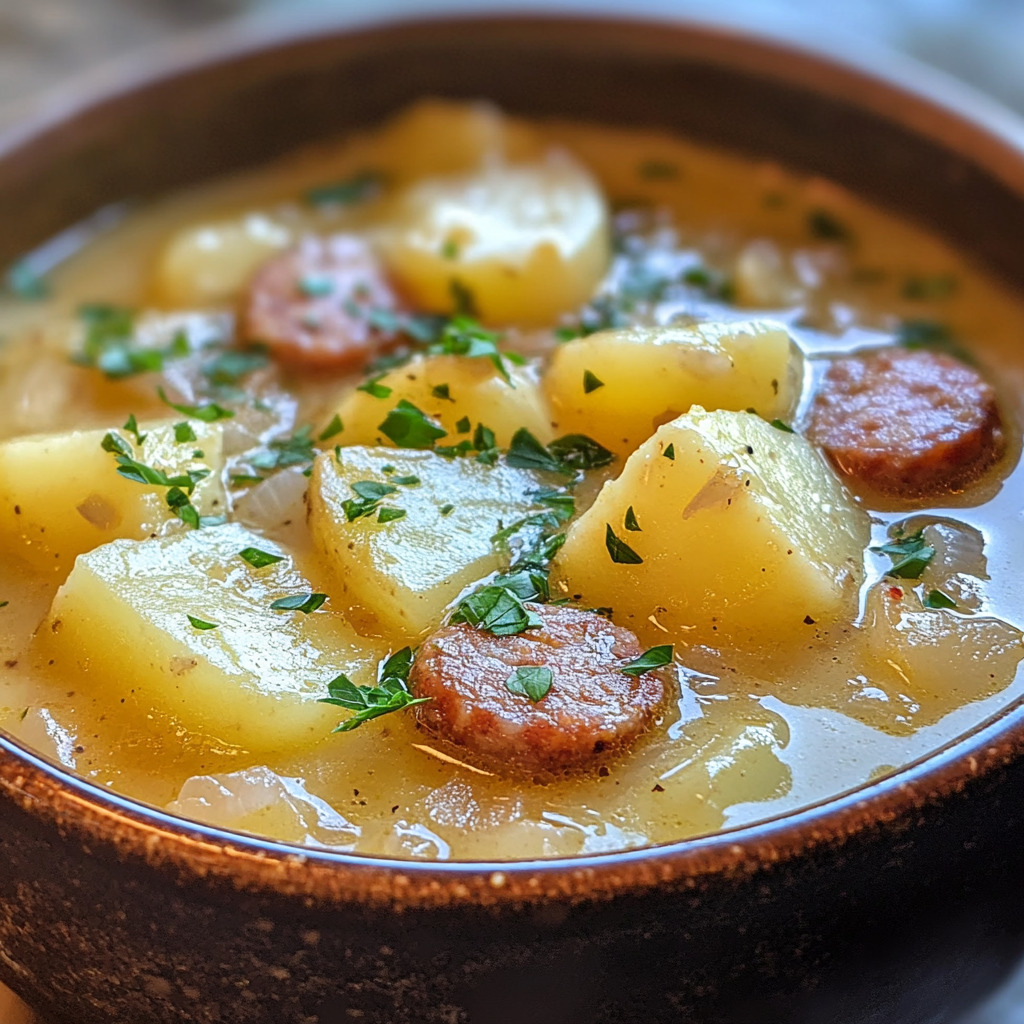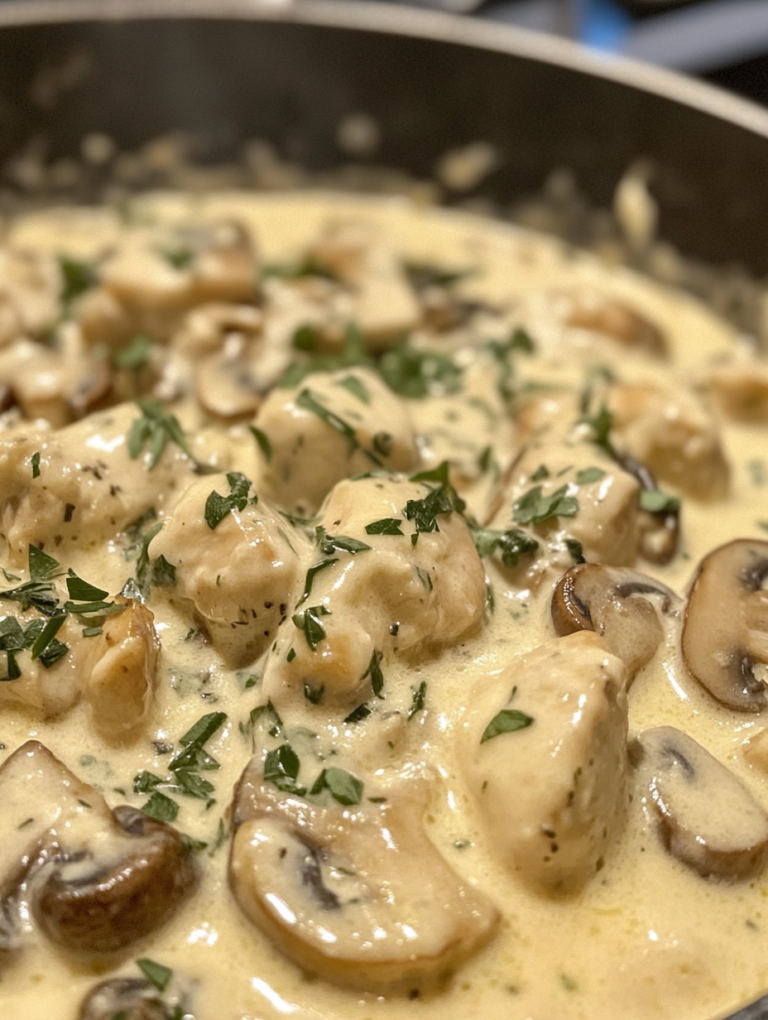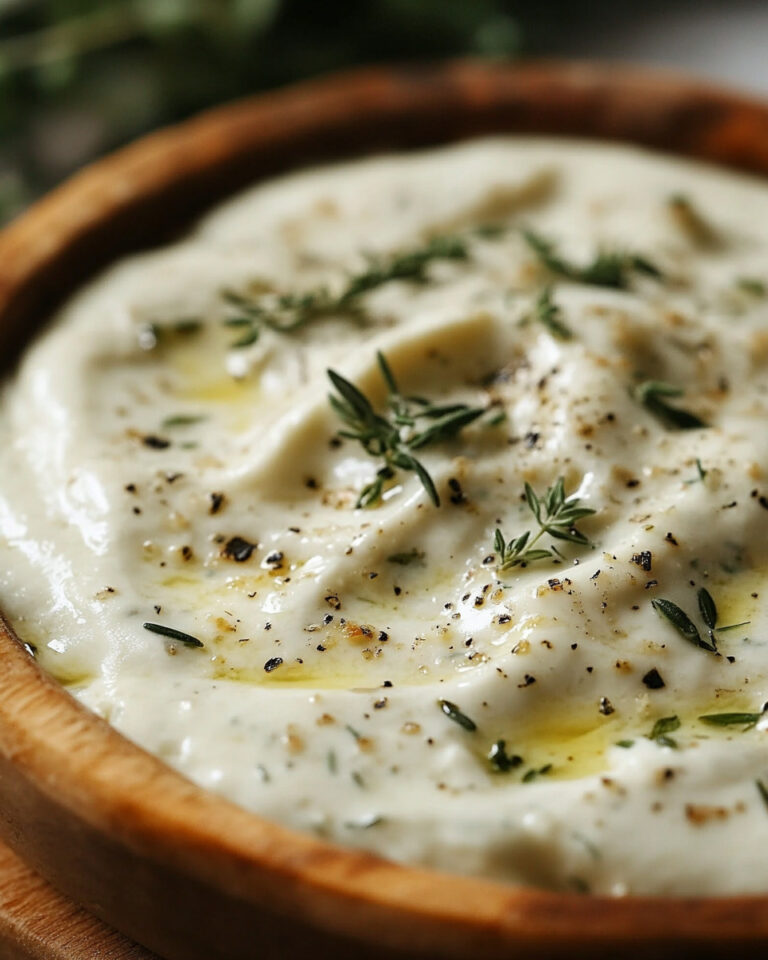Potato Kielbasa Soup: A Hearty Comfort Food Recipe
Potato Kielbasa Soup combines hearty potatoes and flavorful kielbasa sausage for a comforting dish that warms the soul. This recipe balances rich flavors and wholesome ingredients, making it an ideal choice for any season. For those seeking a delicious and easy-to-make meal, Potato Kielbasa Soup delivers nourishment and satisfaction in every bowl.
The creamy texture of the soup, paired with the smokiness of the kielbasa, creates a delightful culinary experience. This dish not only pleases the palate but also offers a great way to incorporate vegetables into one’s diet.
With simple steps and readily available ingredients, preparing this soup is straightforward, making it perfect for weeknight dinners or meal prep. Every bite provides a comforting blend of flavors that can be enjoyed by family and friends alike.
History of Potato Kielbasa Soup
Potato Kielbasa Soup has its roots in Eastern European cuisine, particularly in Poland. It emerged from the need to create hearty meals that provided warmth and sustenance during cold winters.
Kielbasa, a type of Polish sausage often made from pork or beef, has been a staple ingredient for centuries. It pairs well with various vegetables, including potatoes, which are widely grown in the region. This combination results in a filling and nutritious dish.
The soup likely evolved as households sought to utilize readily available ingredients. Traditionally, it is made by simmering the kielbasa with potatoes, onions, and sometimes carrots or celery.
In many Polish families, this soup is a comforting dish, often passed down through generations. Variations exist in different regions, reflecting local tastes and available ingredients.
Key Ingredients:
- Kielbasa: The primary protein source.
- Potatoes: Provide heartiness and texture.
- Onions: For flavor depth.
Cultural significance is also notable. Many people serve it during celebrations or family gatherings, reinforcing its role in Polish heritage.
Today, Potato Kielbasa Soup is enjoyed worldwide, adapting to various culinary preferences while retaining its traditional roots.
Key Ingredients
Potato Kielbasa Soup features a blend of hearty ingredients that contribute to its rich flavor and texture.
- Potatoes: The star of the soup, typically Yukon gold or russet potatoes, provide creaminess when cooked.
- Kielbasa: This smoked sausage adds depth and a savory taste, often made from pork or turkey.
- Onions: Chopped onions enhance the flavor base, providing sweetness and aromatic qualities.
- Garlic: Minced garlic infuses the soup with a robust, savory essence.
- Carrots: Sliced carrots add color and a slight sweetness, complementing the other ingredients.
- Celery: Diced celery contributes crunch and a fresh flavor, balancing the richness.
- Broth: Chicken or vegetable broth serves as the soup’s foundation, adding moisture and depth to the flavor.
- Seasonings: Essential spices include bay leaves, thyme, and pepper, which elevate the overall taste profile.
- Cream or Milk: Optional additions like cream or milk can be stirred in for added richness and creaminess.
These ingredients combine to create a filling and enjoyable dish, ideal for any occasion.
Health Benefits
Potato Kielbasa Soup offers several nutritional advantages. Its primary ingredients provide a variety of essential nutrients.
1. Potatoes:
Rich in vitamins C and B6, potatoes support immune function and brain health. They are also a good source of potassium, which helps regulate blood pressure.
2. Kielbasa:
Typically made from pork, kielbasa is a source of protein and provides necessary amino acids. It can also supply essential nutrients like iron and zinc, important for energy production.
3. Vegetables:
Adding vegetables, such as carrots and celery, enhances the soup’s fiber content. Fiber aids digestive health and can promote satiety, which helps with weight management.
4. Broth:
A hearty broth can provide hydration. Using low-sodium options offers flavor without excessive salt, supporting heart health.
Nutritional Summary:
| Ingredient | Key Nutrients |
|---|---|
| Potatoes | Vitamin C, Vitamin B6, Potassium |
| Kielbasa | Protein, Iron, Zinc |
| Vegetables | Fiber, Vitamins A and K |
| Broth | Hydration, Low-Sodium Options |
Incorporating Potato Kielbasa Soup into a diet can contribute to a balanced meal. It combines proteins, vitamins, and minerals essential for overall well-being.
Preparation Essentials
Preparing Potato Kielbasa Soup requires specific tools, time management, and access to essential ingredients. Understanding these elements will streamline the cooking process and enhance the dish’s quality.
Equipment Needed
To make Potato Kielbasa Soup, the following equipment is essential:
- Large Pot: A heavy-bottomed pot or Dutch oven ensures even heating and minimizes sticking.
- Cutting Board and Knives: Sharp knives help with precise chopping of ingredients, while a sturdy cutting board provides a safe workspace.
- Measuring Cups and Spoons: Accurate measurements of broth, spices, and other components are crucial for flavor balance.
- Ladle: Ideal for serving the soup smoothly without spills.
- Stirring Spoon: A long-handled spoon prevents burns and allows for effective mixing.
Having these tools ready will facilitate a smooth cooking experience.

Prep Time and Cooking Time
Preparation of Potato Kielbasa Soup typically involves about 15-20 minutes of chopping and measuring ingredients. Cooking time varies between 30-45 minutes.
- Preparation:
- Chop potatoes and kielbasa into bite-sized pieces.
- Dice onions, carrots, and celery.
- Cooking:
- Sauté the vegetables for about 5-7 minutes.
- Add liquids and kielbasa, and then allow the soup to simmer until the potatoes are tender.
Timing is key; proper attention ensures that vegetables retain their texture.
Sourcing Ingredients
For a flavorful Potato Kielbasa Soup, sourcing quality ingredients is essential:
- Potatoes: Choose russet or Yukon gold for the best texture. Look for firm, unblemished specimens.
- Kielbasa: Fresh kielbasa adds depth. Purchase from local butchers for optimal taste.
- Broth: Low-sodium chicken or vegetable broth enhances flavor while allowing for control over saltiness. Homemade broth is a good option.
- Vegetables: Fresh produce, such as onions, carrots, and celery, should be crisp and seasonal for maximum flavor.
Shopping at farmers’ markets or local grocery stores can yield fresher and more robust ingredients.
Cooking Procedure
This section provides detailed steps and tips to guide anyone through the process of making Potato Kielbasa Soup.
Step-by-Step Instructions
- Prepare Ingredients: Start by gathering the following: 1 pound of kielbasa, 3 medium potatoes, 1 large onion, 3 cloves of garlic, 4 cups of chicken broth, and 2 cups of kale. Chop the kielbasa into bite-sized pieces, dice the onions, and mince the garlic.
- Sauté Aromatics: In a large pot, heat 2 tablespoons of olive oil over medium heat. Add the chopped kielbasa and cook until browned, about 5 minutes. Remove the kielbasa and set it aside. In the same pot, add onions and garlic. Sauté until softened.
- Add Potatoes and Broth: Return the kielbasa to the pot. Add the diced potatoes and pour in the chicken broth. Bring the mixture to a boil.
- Simmer: Reduce the heat to low and cover, letting it simmer for 20 minutes or until the potatoes are fork-tender. Stir occasionally.
- Add Kale: Stir in the kale and cook for an additional 5 minutes until wilted. Adjust seasoning with salt and pepper, if necessary.
Tips for the Perfect Consistency
To achieve the right texture, it is essential to manage the cooking times carefully.
- Potato Selection: Use starchy potatoes like Russets to create a creamy consistency. Waxy potatoes tend to hold their shape better but may not provide the desired creaminess.
- Thickness Adjustment: If the soup appears too thick, add more chicken broth or water gradually. For a thicker consistency, mash some of the potatoes against the side of the pot and stir them back in.
- Blend for Creaminess: For an ultra-creamy texture, blend a portion of the soup using an immersion blender. This will give a velvety finish without completely pureeing the entire dish.
- Serving Tips: Serve hot with a garnish of freshly chopped parsley or a sprinkle of paprika for added flavor and visual appeal.
Serving Suggestions
Enhancing Potato Kielbasa Soup involves thoughtful accompaniments and plating techniques. These elements can elevate the dining experience and highlight the soup’s comforting flavors.
Accompaniments
Pairing side dishes and toppings with Potato Kielbasa Soup can complement its rich taste. Consider serving it with crusty bread, such as sourdough or rye, to soak up the flavorful broth.
A light salad with mixed greens, cherry tomatoes, and a vinaigrette dressing can balance the heartiness of the soup. For added texture, crackers or toasted baguette slices can provide a satisfying crunch.
Common toppings like fresh herbs (e.g., parsley or chives) and a sprinkle of smoked paprika can enhance the soup’s presentation and flavor. A dollop of sour cream or Greek yogurt adds creaminess and a tangy contrast.
Plating Techniques
The way the soup is plated can significantly impact its appeal. Using a wide, shallow bowl allows for more surface area, making it visually appealing.
Garnish the soup with fresh herbs placed in the center for a pop of color. A drizzle of olive oil around the edges can add sophistication.
Including accompanying elements like bread or crackers on the side helps create a more complete presentation. Using a complementary colored napkin or simple flatware can enhance the overall aesthetic without overpowering the dish.
Variations
Potato Kielbasa Soup offers numerous opportunities for adaptation. Different dietary preferences and cultural influences can transform this dish into unique variations that appeal to a wider audience.
Vegetarian and Vegan Options
For those seeking vegetarian or vegan alternatives, replacing kielbasa with plant-based sausage is an excellent choice. Many brands offer smoked or spicy plant-based options that mimic the flavors of traditional sausage.
Vegetarians can also include additional vegetables such as zucchini, bell peppers, or carrots to enhance the soup’s flavor and texture. Using vegetable broth instead of chicken broth will ensure the dish remains meat-free.
Legumes like kidney beans or lentils can be added for protein, making the soup heartier without losing its comforting essence. Seasoning with herbs like thyme, rosemary, or smoked paprika can provide depth while maintaining a plant-based profile.
Cultural Twists
Different cultures lend unique ingredients and flavors to Potato Kielbasa Soup. For instance, incorporating sauerkraut introduces a tangy element familiar in many Eastern European cuisines.
Adding spices like cumin or coriander can provide a warming flavor profile typical in Mediterranean variations. Moreover, including rice or noodles can transform the texture, adding a substantial element.
Certain regions might introduce local vegetables such as parsnips or turnips, giving the soup a distinctive taste. Garnishing with fresh herbs like cilantro or dill can elevate the final presentation while infusing freshness into the dish.
Storage and Reheating
Proper storage and reheating of Potato Kielbasa Soup are essential for maintaining its flavor and quality. Following the correct guidelines ensures that the soup remains safe to eat while retaining its delicious taste.
Refrigeration Guidelines
Potato Kielbasa Soup can be stored in the refrigerator for up to 3 to 4 days. It is important to let the soup cool to room temperature before transferring it to an airtight container. This helps prevent condensation, which can lead to spoilage.
When storing, portion the soup into smaller containers to enhance cooling speed and make reheating easier. Place the labeled containers in the refrigerator, and use them within the recommended timeframe. To maintain the best quality, avoid leaving the soup out at room temperature for more than 2 hours.
Freezing and Thawing Procedures
Freezing is a great option for longer storage. Potato Kielbasa Soup can be frozen for up to 3 months. To do this, allow the soup to cool before portioning it into freezer-safe containers or heavy-duty freezer bags. Remove excess air from bags to prevent freezer burn.
When ready to use, it is best to thaw the soup in the refrigerator overnight. For quicker thawing, the microwave can be used, but it’s essential to reheat it immediately afterward. Reheated soup should reach an internal temperature of 165°F (74°C) to ensure safety.
Nutritional Information
Potato Kielbasa Soup is a hearty dish that offers a balance of essential nutrients. Here’s a breakdown of its typical nutritional content per serving:
| Nutrient | Amount |
|---|---|
| Calories | 250 kcal |
| Total Fat | 10 g |
| Saturated Fat | 3 g |
| Cholesterol | 40 mg |
| Sodium | 800 mg |
| Total Carbohydrates | 30 g |
| Dietary Fiber | 4 g |
| Sugars | 2 g |
| Protein | 12 g |
Key Ingredients
- Potatoes: Good source of Vitamin C and potassium.
- Kielbasa: Provides protein and iron.
- Vegetables: Typically includes carrots and celery, adding vitamins A and K.
Health Considerations
The soup can be modified for dietary needs. Lowering the sodium can be beneficial for those monitoring blood pressure. Substituting turkey kielbasa can reduce fat content.

Serving Suggestions
Pairing the soup with whole-grain bread can enhance fiber intake. This meal works well for a balanced diet, combining proteins, carbs, and healthy fats.
Common Mistakes to Avoid
Certain missteps can detract from the quality of Potato Kielbasa Soup. Focusing on the right ingredient proportions and maintaining proper cooking temperatures are critical for achieving the desired flavor and texture.
Ingredient Proportions
Using incorrect ingredient proportions can lead to an unbalanced flavor profile. For example, adding too much potato may result in a thick, starchy consistency. Ideally, the ratio of potatoes to kielbasa should be around 2:1.
Ensure that the seasonings are also proportional. A typical guideline is to use 1 teaspoon of salt for every 4 cups of broth. Adjusting the amount of broth is vital to achieving the right soup consistency, as too much will dilute the flavor.
Many overlook the importance of vegetables. Aim for 1 cup of chopped onions and 1 cup of carrots to enhance flavor. Measurements may need to be adjusted based on personal taste, but it’s best to start with these recommended amounts.
Cooking Temperature
Maintaining the correct cooking temperature is essential for maximizing flavor and texture. Cooking the soup at too high a temperature can cause the potatoes to become mushy too quickly, disrupting the intended texture.
A gentle simmer is ideal, typically around 180–200°F (82–93°C). This allows the flavors to meld properly without overcooking the ingredients.
Overcooking can also dull the flavors. To avoid this, keep an eye on cooking times. Generally, it takes 20-30 minutes to reach a tender consistency for the potatoes. Regularly stirring can help maintain even heat distribution and prevent sticking.







